 Winter months are tough on dairy calves.
Winter months are tough on dairy calves.
When the temperature starts to drop below 50 degrees Fahrenheit, calves can start to struggle health and growth wise. Keeping calves warm and comfortable is a priority!
Here are a few tips and tricks I do or have seen to give calves the best start to life when born in the winter.
-
- Warm/dry environment for newborn calves:
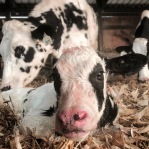
Calves are toasty warm inside the cows at 101.5 degrees. When the calf hits the ground, it’s important to get them into a warm and dry environment ASAP. Where they calve in is important as well. Our calves are born on a bedded pack with corn stalks which is re-bedded every other day typically.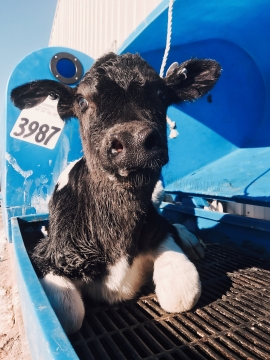 We personally use calf warmers to dry off and warm up our calves. It’s a blue dome that the calves lay in. There is a heater attached on the bottom right side which blows warm air directly inside the PolyDome. Calves typically can be dry in 4-5 hours. All depends on the size of the calf and if the cow licked them off a bit prior to being put inside them. They are easy to clean which I love.Other ways to warm & dry off newborn calves:
We personally use calf warmers to dry off and warm up our calves. It’s a blue dome that the calves lay in. There is a heater attached on the bottom right side which blows warm air directly inside the PolyDome. Calves typically can be dry in 4-5 hours. All depends on the size of the calf and if the cow licked them off a bit prior to being put inside them. They are easy to clean which I love.Other ways to warm & dry off newborn calves:
– Heat lamps
– LOTS of straw
– Place a couple 5 gallon containers (with lids) of 160* water inside a hutch. (cover hutch with old blanket or door) Ask Dairy Carrie for more information on this.
– Put socks on calves back feet – Questions about this? Ask Megan.
– Some people put calf jackets on their calves at birth. I personally don’t. I believe it makes the calf colder, and I think they stay wet longer than they would without a jacket. (I could be wrong.)Our calves get jackets AFTER they are all dry. Which leads into the next tip… - Calf Jackets (blankets):
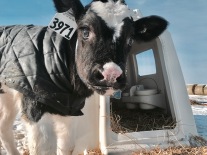
When the temps drop below 50 degrees Fahrenheit, jackets are essential for keeping your calves warm. Calf jackets are placed on my calves once they’re completely dry. Then they are kept on till the calves are roughly 4 weeks old. After that, they are taken off (on a warm day) and washed and dried. We buy ours through Nasco. - Lots of fresh bedding:

“Mom, that’s enough.”
I bed my calves up a few times every week with wheat straw. It not only keeps them dry, but it keeps them warm. Adequate bedding will give you a bigger calf at weaning. The more heat they can keep in, the more energy they will use to grow rather than to stay warm. A bigger calf at weaning time could result in a higher producing cow in the future (more milk!). Not sure how much straw is enough? Check out the nesting score.
- Doors for hutches:

I have about 90+ calves on milk at a time. When snow/wind storms hit or when we have a newborn calf, we want the hutches to keep the snow/wind out and the heat in. We purchased 50 doors for our hutches from Genesis Enterprises at World Dairy Expo 2 years ago and use them all the time. All of our newborn calves receive a door when they are moved to the hutches and the door stays on for at least 3-4 days when its below 30 degrees out. *Doors fit different hutch styles and are easy to clean too**If you do not have doors for your newborn calves,a barrel works to cover the fronts of the hutches to keep those new calves inside. Have questions about that? Ask Becca.*
moved to the hutches and the door stays on for at least 3-4 days when its below 30 degrees out. *Doors fit different hutch styles and are easy to clean too**If you do not have doors for your newborn calves,a barrel works to cover the fronts of the hutches to keep those new calves inside. Have questions about that? Ask Becca.* - Extra feeding of milk:

We personally don’t feed an extra feeding of milk during the day, but some farmers do and they find it helpful. Ask Darcy on instagram how she manages to feed an extra feeding. - Offering warm water:

With Dr. Neil Michael at 2017 PDPW Business Conference
I offer warm water 365 days a year, but some farms do not. Calves will drink warm water a lot better than they will drink cold water, especially in the winter (even in the summer). Calves enjoy water at the same temperature as they’d receive their milk at. Offering it as soon as you can will also increase the amount that they drink. The faster it gets to them, the better. Dr. Neil Michael with Arm & Hammer taught me that calves will consume their calf starter better if they have water to go with it.
- Leave calves on milk longer:
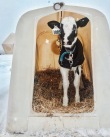 If the weather is extremely cold, I will keep my calves on milk longer. Sometimes it’s just a few days, maybe a week. Depends on the weather and how the calves are growing and eating their calf starter.
If the weather is extremely cold, I will keep my calves on milk longer. Sometimes it’s just a few days, maybe a week. Depends on the weather and how the calves are growing and eating their calf starter. - Insulation panels:

Jessie adds insulation panels to her individual calf pens to try and lock in heat in her calf barn. Insulation panel is located on the back of the pen in the picture to the right. - Double calves up in hutches or pens:
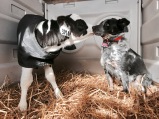
Dogs work too, right?
I personally don’t double up calves because it’s not possible with my set up, but I have seen farmers put two calves in a hutch in the winter to keep them warmer. Doubling up calves has also been known to increase growth in the those calves. The competition with the other calf in the hutch, makes them want to eat more. Eating more will result in a bigger calf.
- Warm/dry environment for newborn calves:
Anything I missed? Leave your thoughts in the comments.
Hope these winter tips help you care for your calves!
Sincerely,
Jenna, Crazy Calf Lady

Hi
Do you give them any vaccines?
What do you use or give for treatments if needed?
What is the fat and protein in your calf powder?
I raise calves too, so I’m just curious. I think I still have a lot to learn.
LikeLike
I’m in 4-h so I have calves that I raise for the fair each summer, a lot of times I just can’t seem to make them grow as big as others. What type of feed do you typically give in the first 3 months? That’s the problem I have is because I’m still trying to figure out what feeds make them grow the best
LikeLike